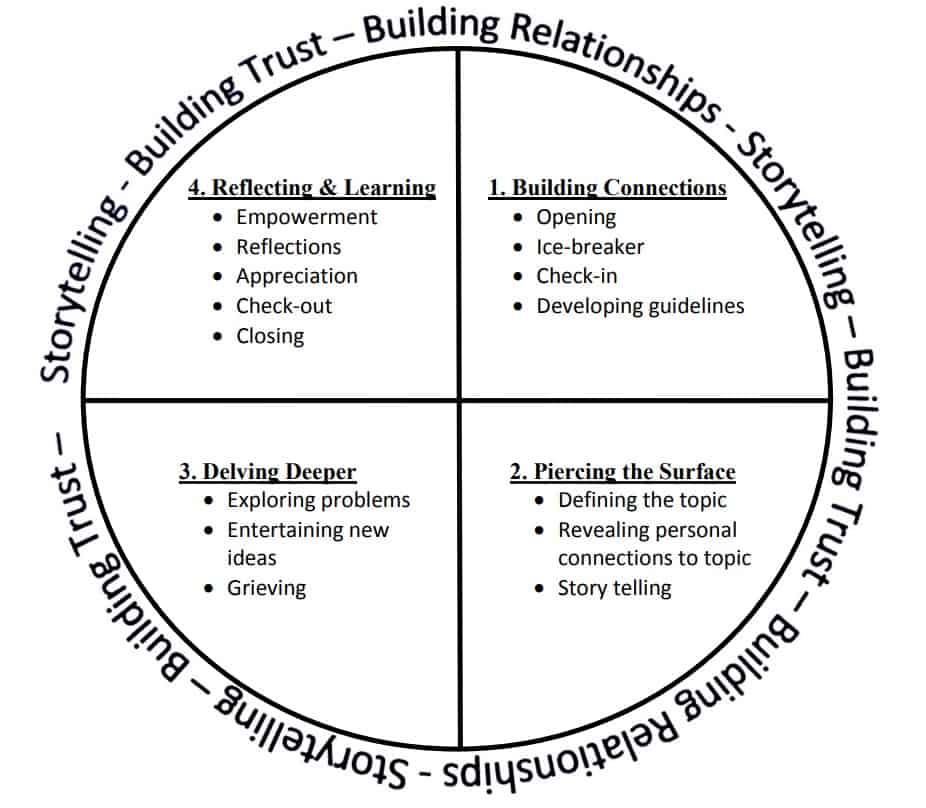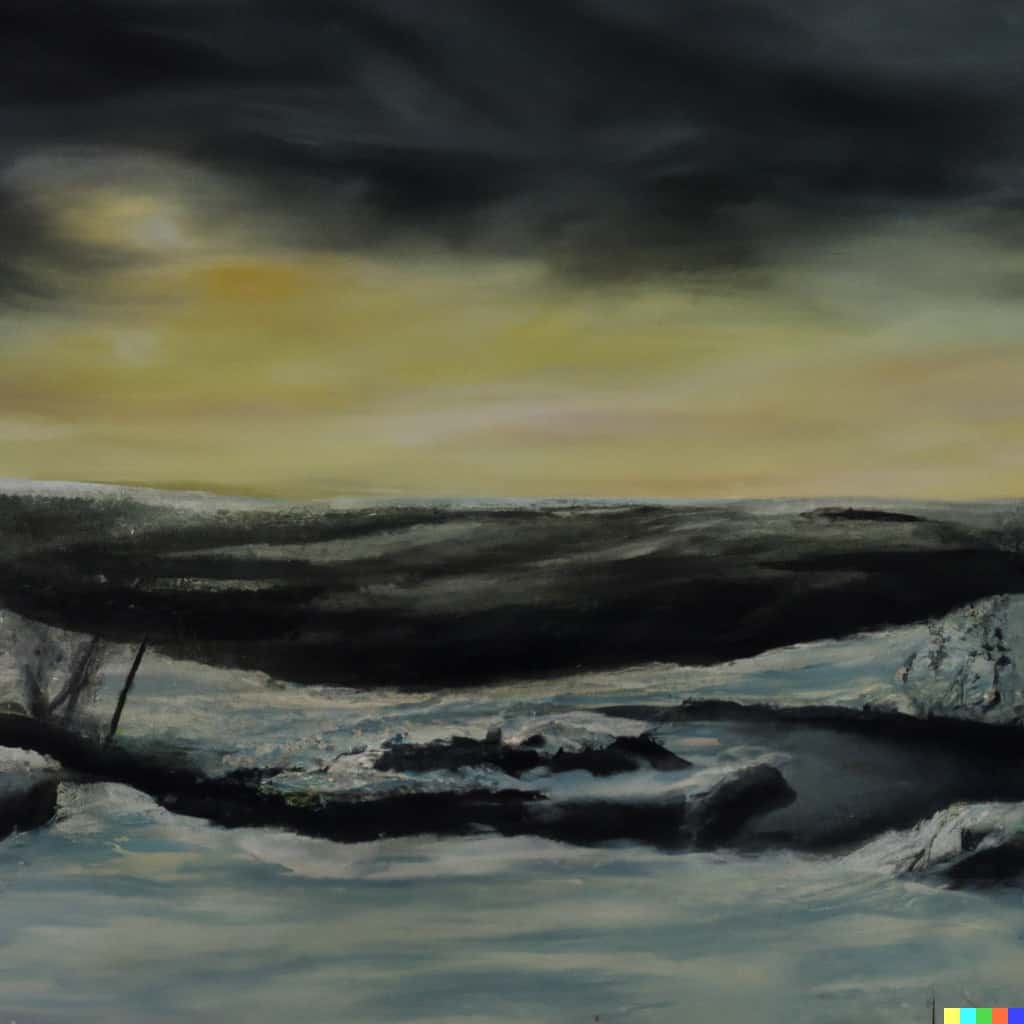Overview
This lesson merges the worlds of artificial intelligence (AI) and poetry. Students read a poem and decipher it to analyze tone, emotions, and symbolism. Students use DALL-E-2 to create an AI-generated rendition of the poem based on their critical analysis.
Learning Objectives
Through this cross-curricular lesson, students read the poem Holding Grief by Ashley Qilavaq-Savard and illustrate the poem using DALL-E.2. This allows students to make innovative and meaningful connections between artificial intelligence (AI) and literature, thus exploring a new medium of expression.
Curriculum Links
Ontario: Reading and Literature Studies
- 1 – Reading for Meaning
- 2 – Understanding Forms and Styles
- 3 – Reading with Fluency
- 4 – Reflecting on Skills and Strategies
Ontario: Oral Communication
- 1 – Listening to Understand
- 2 – Speaking to Communicate
Nunavut: Uqausiliriniq
- Communication
- Language
- Creative & Artistic Expression
- Reflective & Critical Thinking
Vocabulary
- uummati
- heart
- nuna
- land
- aqsarniit
- northern lights
- sila
- weather
- siku
- ice
- imiq
- water
- Talking Circles
- Talking Circles, also called peacemaking circles, come from the traditions of Indigenous Peoples of North America, particularly tribes in the Midwest. Circle processes are based upon equality between participants and the principle of sharing power with each other instead of having power over one another. Talking Circles can be used for discussion, problem-solving, and/or decision-making. The basic purpose of a Talking Circle is to create a safe, non-judgemental place where each participant has the opportunity to contribute to the discussion of difficult and/or important issues
Reading and Critical Analysis
To begin the lesson, read the poem Holding Grief.
If I give my heart to the land, will it hold grief like I do? Too tightly and too long
it rolls in like thick ice fog in the dead middle of winter
drowning in debilitating delicacy
frost full of fragility
reassure that resilience is resting nearby
waiting for this all too familiar
Nothing feeling to disappear
Nothing feels empty, quiet, seemingly safe
Nothing likes to take time and lose it
more than grief
I don’t notice this feeling seeping into my roots
like lifeless dry leaves slowly spreading
decay to Indigenous lineage
I’d never imagined a drought could happen in the Arctic tundra that is my
home
until I felt it reached to my veins, right to my core
I stand staying still as seasons change around me
letting this Nothing become me as I wait for vitality
I learned with wasted time that one does not wait for resilience to be
awoken
revival of resilience begins with a cry
a release
of sadness
regret
grief
feelings flooding in, not to be drowned in but to replenish and clearance the inner self
I gave my uummati to the nuna
not to let this all too familiar Nothing consume me
(Source: “Where the Sea Kuniks the Land” by Ashley Qilavaq-Savard)
After reading the poem, lead the discussion with the following prompts:
- In your opinion, what is the format and structure of the poem?
- Do you find any symbolism in the poem?
- Do you identify any rhyming scheme in the poem? Or is the poem in free verse?
- Determine the voice and tone of the poem. What words or images convey the tone?
- Are you able to decipher the poet’s feelings through her words? What do they convey?
- Does the ending offer closure to the story?
Poetic Tools and Structures
Poets use a variety of tools and structures to enhance the meaning and emotional effects of their work. Some of these are:
- Simile – A comparison stating one thing is like another: “leaves me like a needle”
- Metaphor – A comparison stating that something IS something else; using one thing to designate another: “in the haystack of light”
- Hyperbole – An exaggeration to create a strong impression or emphasize a point: “more or less kills me”
- Rhyme – Correspondence of sound between words or the endings of words, especially when these are used at the ends of lines of poetry: “delight/light”
- Alliteration – Repetition of consonant sounds, usually at the beginning of words: “to look, to listen, to lose myself”
- Assonance – Repetition of a vowel sound: “that leaves me like a needle”
- Point of View – (in fictional writing) The narrator’s position in relation to the story being told, e.g. first person, second person, or third person
After reading the poem, ask the students to identify all the poetic devices and elements that have been used to express the meaning and emotions of the poem. The students should be able to identify all the above mentioned elements in the poem.
Talking Circle Activity
The teacher can also host a Talking Circle. Talking Circles are characterized by the use of a talking piece, which regulates communication. Both talking and listening are important in the circle because mutual understanding lays the groundwork for deeper, more meaningful discussion. Only the participant holding the talking piece may speak. Participants who do not have the talking piece listen and reflect on what the person with the talking piece says. The talking piece is a meaningful and symbolic object that the facilitator, also called the circle keeper, brings to the circle. The circle keeper often incorporates an explanation of the meaning of the talking piece into the circle activities.

Receiving the talking piece is an invitation to share with the group and helps ensure that everyone gets an opportunity to share at their own pace and in their own way without interruption. Participants share what they want, can remain silent during their turn, or pass by giving the talking piece to the next person. The talking piece is passed clockwise around the circle with each participant having a turn to share their authentic personal stories and have them respectfully heard and acknowledged without judgement, condemnation, or advice (unless advice is solicited).
Follow the steps for the Talking Circle discussion:
- Establish a talking piece and respect it so the person who has it can convey their full message without interruption. Those who do not have the talking piece, listen respectfully and reflect upon, consider, and honour the meaning of what others say in order to build on the conversation.
- You can pass if you wish. Non-verbal communication and silence sometimes say more than words.
- Mute cellphones and computer devices to avoid interrupting others.
- Speak for yourself and from your own experiences and perspectives. Use “I” language instead of generic language, like, “people think. . .,” or sweeping generalizations, like “students want. . .”.
- Be courageous, honest, and open with your own stories. Speak your truth from your heart and be open to hearing others’ truths.
- Listen with the heart, allowing what others say to move you. Bear witness but do not provide advice or argue.
- Honour what others say with confidentiality and integrity, sharing only with context and in relevance to your own life and learning, not as gossip.
- Take notes of the discussion to be used as a reference point for the next activity. These will be your “critique notes.”
Using the poem and its metaphorical meaning as a topic of discussion, ask students to share their similar experiences or thoughts, and what new perspectives they have gained. Once the students have deciphered the meaning of the poem, ask them to note their ideas as a reference point for the computer activity.
Computer/Tech Activity – DALL-E 2 OpenAI
Ask the students to review their notes from the previous activity. Use the first five minutes of the lesson to go over the poem and its structure, tone, and symbolism.
- Go to DALL-E-2, an openAI tool, and sign up. Refer to the notes and find the most accurate description of the poem. Type the sentence in the search bar and hit Generate. Here are some examples of AI-generated images based on the poem:

- Take other excerpts from the critique notes and create a story of an Inuit woman depicting resilience in the face of adversity. Use the openAI tool to illustrate the story and create an illustrative piece of art.
- Students can also explore different styles of painting, for example: Van Gogh, Picasso, mosaic, or abstract. The following images were generation by the prompt, “Create a Van Gogh-style painting of an Inuit woman standing in the frozen tundra.”
- Present the illustrative story to peers to gather feedback and find ways to continue the discussion.
Resources
- To learn more about Talking Circles, read the paper “Using Talking Circles in the Classroom” by Alaina Winters and Heartland Community College
- To explore more poems and literature from the Indigenous artists, check out books and reading material from Inhabit Media
- To learn more about Nunavut-based educational resources, check out books and reading material from Inhabit Education Books












